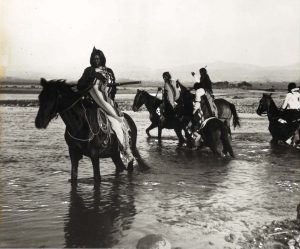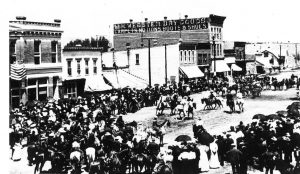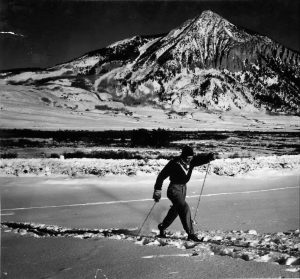Crested Butte and Gunnison History
Crested Butte and Gunnison have a rich history beginning hundreds of years ago with the Ute people all the way to the present. Today the valley is known for beautiful Colorado mountain views, world-class mountain biking and skiing, and 1200+ miles of trails to recreate on. Gunnison Valley has seen many changes and has been integral in important parts of Colorado’s history. Let’s take a look back and share some highlights of Crested Butte and Gunnison history.
The Utes
Recorded history in Gunnison Valley begins with the Ute people. Two bands of Ute people resided in present-day Gunnison County during the summer for hunting. The Parianuches, meaning “elk people”, lived to the north of the Gunnison River and the Tabeguaches, later referred to as the Uncompahgres, lived in much of the Gunnison Valley. The Utes in Gunnison Valley were hunter-gatherers and lived a nomadic life that followed the migration of the large game they hunted. Researchers believe the Utes came to Gunnison Valley in the 16th century. The Spanish began colonizing New Mexico in the 16th century and made their way into Ute territory. This was the beginning of the Utes ultimate forceful removal from the land. Other Europeans and gold miners entered the area, resulting in disease, violence, and displacement for the Utes until 1880 when the few remaining were forcibly removed by the US government and placed on the Uintah-Ouray Reservation in Utah. Ute culture centers around the land, and Utes believe they are stewards and residents rather than owners of it. Their way of life was, and still is, one of being connected to the land and using it in the most sustainable way possible. This lifestyle allowed the land to thrive and flourish for hundreds of years and still be here today.

The Beginning of Crested Butte and Gunnison As We Know Them Today
Gunnison Valley gets its current name from the explorer Captain John W. Gunnison. He was tasked with finding a railroad route to the Pacific through the Rocky Mountains. He arrived in the valley in 1853. A colony was established in 1874 but didn’t gain traction until a few years later. Crested Butte began as a supply town for surrounding silver mining communities in 1878 and was incorporated in 1880. It got its current name in 1873 from Ferdinand V. Hayden, who looked out at present-day Crested Butte and Gothic from the top of what is now Teocalli Mountain and called them‚ the crested buttes.
Mining in Crested Butte and Gunnison
High-quality coal beds were discovered outside Crested Butte in 1880 and by 1882 Crested Butte coal mines were the most productive in the Colorado Rockies. Two years later there was an explosion in the Jokerville Mine, the highest producing in town. Around 60 workers were killed. This tragedy rocked the town and was a catalyst for encouraging Colorado miners to embrace unionizing. Coal mining was vastly important to building Colorado’s infrastructure and industry and remains a large industry in the state today. Jokerville was reopened in 1885 and operated for ten years, closing once in 1891 because of a labor strike, before permanently closing once a larger coal seam was discovered in the area. Silver mining began to decline in 1893 with the silver panic, causing other mining towns in the area to fail. Crested Butte survived these closures because of its bituminous coal reserves. Big Mine was opened in 1894 and closed in 1952, ending coal mining in Crested Butte. The first known gold was discovered in Gunnison along the Taylor River in 1861. Utes in the area prevented mines from being built until The Treaty of 1868 created the Consolidated Ute Reservation, which forced them to the western part of present-day Gunnison County. This removal allowed for other gold discoveries, but mining didn’t really take off until silver ore was discovered in the Elk Mountains in 1872. More gold and silver were discovered in the area in 1879, which helped attract more settlers to the already established small colony. It was around this time that marble was discovered in the Crystal River Valley as well. The silver panic hit Gunnison mines hard; while these mines closed many miners turned to coal mining in Crested Butte until those mines also closed.
However, mining hasn’t totally been removed from Crested Butte. Mt. Emmons, more commonly known as Red Lady, has the third-largest known deposit of molybdenum in the world. Molybdenum is a chemical element used to strengthen steel. It was discovered in Crested Butte in 1977 and began a decades-long battle over the creation of a new mine that is still ongoing. Several different mining companies have tried to open a mine over the years but have always left, either because of citizen activism groups or the price of molybdenum dropping, or a combination of both. Currently, Mt. Emmons Mining Company holds the mining patents for Red Lady. As of 2021, they have proposed a deal that would involve a land swap with the Forest Service, land conservation, and ultimately an end to the potential of mining on Red Lady. This deal would be a huge win for Crested Butte and the countless citizens and activism groups who have fought hard for decades to ensure the preservation of Red Lady.
Ranching in Gunnison
While mining was going strong in the 1880s, ranching and farming was taking off in Gunnison County. When the last remaining Utes in the area were forcibly displaced after the Meeker Incident in 1879, Gunnison Valley opened to white agriculture. This began a process of trial and error to see what kinds of crops would grow best in the valley. Hay and potatoes had the most success, but it wasn’t until the onset of cattle ranching that the agricultural industry really took off. The dramatic weather cycles in the valley made growing crops challenging, so farmers found the land was better suited to raising cattle. Hay production and good summer grazing conditions drew ranchers to the area and built up the ranching industry. By 1900 ranching surpassed mining as the top industry in the valley.

Skiing in Crested Butte
Skiing has been around Gunnison Valley for centuries as a popular form of winter transportation brought over with miners from Europe. Recreational skiing has been around since the 1890s when competitive racing was introduced. Searching for a way to downhill ski without the trek up the mountain, some Gunnison skiers created Pioneer Ski Area up Cement Creek Road. This ski area wasn’t the first in the valley, but it did have the first chairlift in the state. The men moved an abandoned tram from a mine near Cumberland Pass and used cables, also from the old mine, to attach 80 chairlifts, which were constructed with materials from the mine as well, to the tram. When it closed in 1952 Monarch Ski Area bought the chairlift.
Crested Butte Mountain Resort (CBMR) opened in 1961, kicking off Crested Butte’s history as a ski town and popular tourist destination. CBMR was started by Dick Eflin and Fred Rice when they purchased a plot of ranchland on Crested Butte. The resort began with a T-bar until 1963 when a gondola, only the second in the state, was constructed. The resort struggled to stay open for its first ten years, but the extreme terrain and high snowfall have made it one of the most popular ski areas in Colorado today.

Mt. Crested Butte is considered one of the birthplaces of freeskiing. CBMR also pioneered extreme telemark skiing events and competitions. Telemark skiing experienced a revival in Crested Butte in the ’70s when a man on the ski patrol named Rick Borkovic started experimenting with Nordic gear to make turns on Mt. Crested Butte’s steep terrain.
Public Lands in Gunnison and Crested Butte
Gunnison Valley is known for millions of acres of public lands, but these lands weren’t always designated as such. As mining, ranching, and agriculture took off there were concerns about preserving and conserving the land and using it efficiently. The federal government got involved, much to the opposition of ranchers, and established forest reserves and reclamation projects while also imposing new regulations on land use. Though these measures were opposed by some, they ended up being an important part of Colorado’s history. Two forest reserves were created in 1891 and 1892: White River Forest Reserve and Battlement Mesa Forest Reserve. This was the beginning of a new approach to land and resource use and protection in Colorado. Today the National Park Service, the Forest Service and the Bureau of Land Management all have a presence in Gunnison County.
History of mountain biking in Crested Butte and Gunnison
The Gunnison Valley is one of the places where mountain biking was first pioneered. “The Grubstake Gang,” a group of young, wild Crested Buttians, first started riding “klunkers” on the dirt roads of the nearby mountain passes in the 1970s. The bikes evolved, and so did the riders. Hartman Rocks transformed from a forgotton plot of BLM land to a trails paradise. The Born From Junk films chronicle mountain biking’s origins in the Gunnison Valley, from its humble beginnings on stock trails around Crested Butte, to Gunnison Valley local Susan DeMattei’s triumphant performance at the 1996 Olympic games. Watch both films for free here.
Gunnison and Crested Butte Today
Though mining in Gunnison County ended in 1952, Crested Butte and Gunnison still have strong traditions of ranching, skiing and enjoying public lands. Cattlemen’s Days is a world-renowned rodeo that began in 1900 that celebrates and commemorates the important role ranching played in Gunnison Valley’s history. Residents of the valley spend their summer days mountain biking and hiking and winter days skiing, both downhill and Nordic, and every other mountain sport you could dream of in-between. Visitors come from all the over the world to check out our trails, wildflowers and ski slopes.
The Crested Butte Museum has an exhibit honoring the Utes, and the Ute Indian Museum in Montrose has even more. To get a more tangible glimpse into our past check out the Crested Butte Museum in Crested Butte and the Pioneer Museum in Gunnison.

